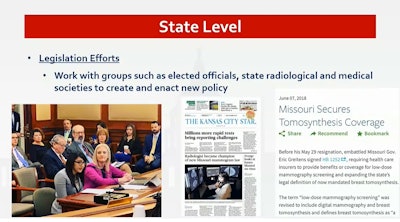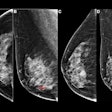Advocacy is needed to drive state and federal legislation on insurance coverage for women with dense breasts, according to a talk given May 1 at the American Roentgen Ray Society (ARRS) annual meeting in San Diego, CA.
In her presentation, Amy Patel, MD, medical director of the Breast Care Center at Liberty Hospital in Missouri, discussed the current state of breast density legislation and how radiologists can become more involved in advocacy in this area.
“There’s no excuse,” Patel said. “There are so many ways to get involved.”
Breast density has come under focus in recent years as states continue to introduce and enact laws mandating insurance coverage for women with dense breasts who need supplemental imaging along with their mammograms. While the Affordable Care Act (ACA) requires coverage of screening mammograms, these women need follow-up testing, such as supplemental MRI or ultrasound.
On the federal level, the U.S. Food and Drug Administration (FDA) in 2023 established a mandate requiring that imaging facilities disclose breast density information to patients. This went into effect in September 2024.
Laws addressing insurance coverage have also been introduced to Congress, such as the Find It Early Act and the Access to Breast Cancer Diagnosis Act. These laws aim to remove barriers to breast care, such as out-of-pocket costs for diagnostic imaging services.
In a separate presentation at ARRS 2025, Sonia Samant, MD, from Corewell Health and Michigan State University in East Lansing, reported that as of August 2024, 27 states (including Washington, DC) mandate insurance coverage of supplemental screening. Eight others have introduced legislation that has either expired in committee or was not signed into law. However, Samant and colleagues found considerable variability between state-level laws in the absence of a federal standard.
“Currently, patients do not have insurance coverage by and large for their supplemental screening with breast MRI or whole breast ultrasound, so they’re really dependent on legislation,” she said. “And patient access to care currently depends on patient’s geographic location or, in the absence of a state legal standard, the patient’s financial resources.”
Still, Samant highlighted that the results show bipartisan and broad public support for these laws to be implemented.
Some states that already have breast density notification laws in place have overlapping language with that of the FDA mandate. However, these duplicative laws may cause confusion among patients and physicians, Patel said.
Patel has been working with Missouri state legislators to rescind the state’s breast density notification language, so that only the FDA language regarding breast density could be placed in the patient lay letter. Currently, radiologists need to include language from both in lay letters to patients.
“For now, we’re just burying the Missouri language at the bottom of the patient lay letter and keeping the FDA language at the top, so that patients are hopefully really only focusing on the FDA language,” Patel said.
Patel, in her presentation, also outlined several tangible examples of how radiologists can do their part to advocate for better breast imaging access to patients.
On the local level, this could mean site visits to engage elected officials or speaking directly to patients in the community or through media channels. On the state level, this could involve joining state radiological societies, forging relationships with state lobbyists, and working with officials and medical societies on creating and enacting legislation.
 In her ARRS 2025 presentation, Amy Patel, MD, discussed ways that radiologists can be proactive in influencing legislation that addresses breast density. These include working with elected officials and joining medical societies, among others.ARRS
In her ARRS 2025 presentation, Amy Patel, MD, discussed ways that radiologists can be proactive in influencing legislation that addresses breast density. These include working with elected officials and joining medical societies, among others.ARRS
Patel also highlighted advocacy efforts from the American College of Radiology, the Radiology Advocacy Network, and the political action committee RADPAC. She also encouraged attendees to use social media to their benefit in spreading awareness.
“This is a call to action to all of you,” she said. “There’s so much that we can do together to help pass critical pieces of legislation when we have so many resources. It’s just a matter of diving in and getting involved.”



















